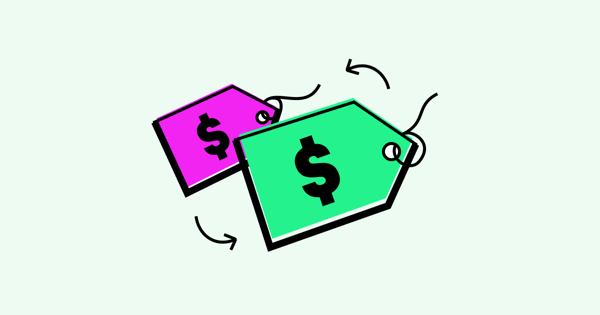Converting an ecommerce lead into a first-time buyer is a big deal.
Suddenly, they’re no longer just another name on your marketing list: they’re a paying customer.
Which means they’re well on the way to becoming a loyal repeat buyer. And, as we all know, loyal customers spend more, stick with you after negative experiences, and are more likely to recommend you to friends and family.
Whoa—let’s pump the brakes for a minute.
Sure, some first-timers will turn into high-value repeat customers. But lots more will purchase once, then slip away like Homer Simpson backing into a hedge.
That’s why, in this article, I’m going to share some of Drip’s tried-and-trusted customer-first strategies for transforming casual shoppers into repeat buyers.
Who Are “Casual Shoppers”?
When we talk about “casual shoppers”, we’re specifically referring to people who’ve signed up to your email list and placed exactly one lifetime order.
They could go on to make a bunch more purchases. Or this might turn out to be a one-and-done relationship.
Unfortunately, most customers fall into that second bucket, with research showing there’s only a 27 percent chance a customer will buy again after placing their first order.
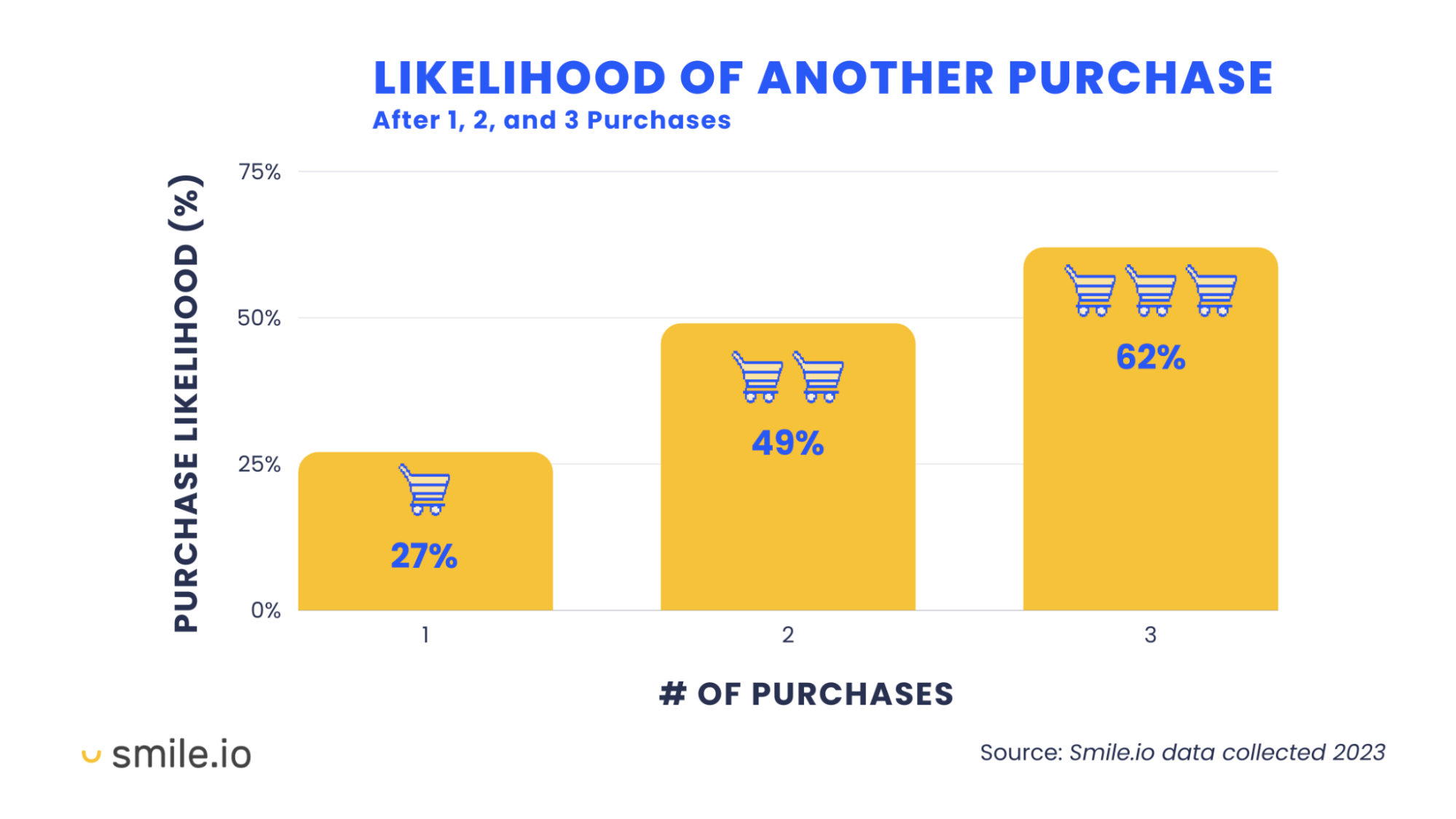 But, as that chart demonstrates, the likelihood of buying again increases significantly with each order a customer places.
But, as that chart demonstrates, the likelihood of buying again increases significantly with each order a customer places.
So if you can compel more first-timers to make a second purchase, you can expect a big uptick in your customer lifetime value.
Four Strategies for Engaging & Converting Casual Shoppers
Any number of external factors might stop a casual shopper from buying again. But you’ve got a better chance of driving repeat purchases if you employ these customer-first strategies and workflows…
Strategy #1: Get to Know Casuals Better
The biggest barrier to your chances of re-converting casual shoppers is that you simply don’t know them well enough yet.
But you can change that.
Which is precisely the aim of this repeat purchase strategy:
1. Build an Onsite Quiz
Want to know the best way to find out what your customers love? Ask them.
Creating an onsite quiz lets you gather valuable data to inform your future email and onsite marketing campaigns, giving you a better chance of crafting the type of messaging that casual shoppers won’t be able to resist.
Note: You’ll be targeting everyone with your onsite quiz, not just casuals. But that’s hardly a problem; what brand doesn’t want to know more about their customers?
Now we’ve cleared that up, let’s take a look at this strategy in action, courtesy of natural skincare brand Three Ships.
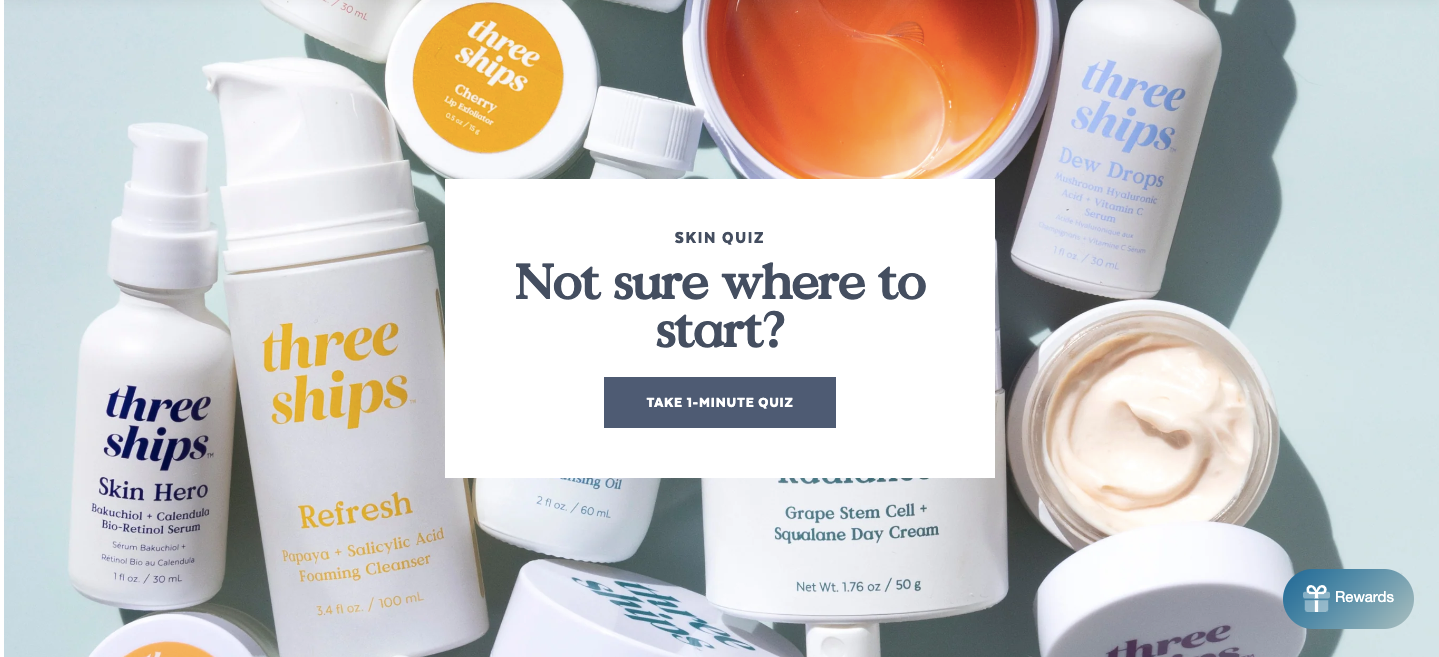 Their quiz asks a bunch of questions about your beauty regime and preferences, from your skin type and skincare goals to the types of products you’re interested in and the values and causes you support.
Their quiz asks a bunch of questions about your beauty regime and preferences, from your skin type and skincare goals to the types of products you’re interested in and the values and causes you support.
All of which means that when Three Ships reaches out to casual shoppers, it’s not trying to close the deal from scratch. Instead, it’s showcasing a bunch of products and offers that perfectly align with the buying behaviors of individual customers.
2. Share Results Through Email
Having gathered all that data, Three Ships follows up by sharing the results via email:
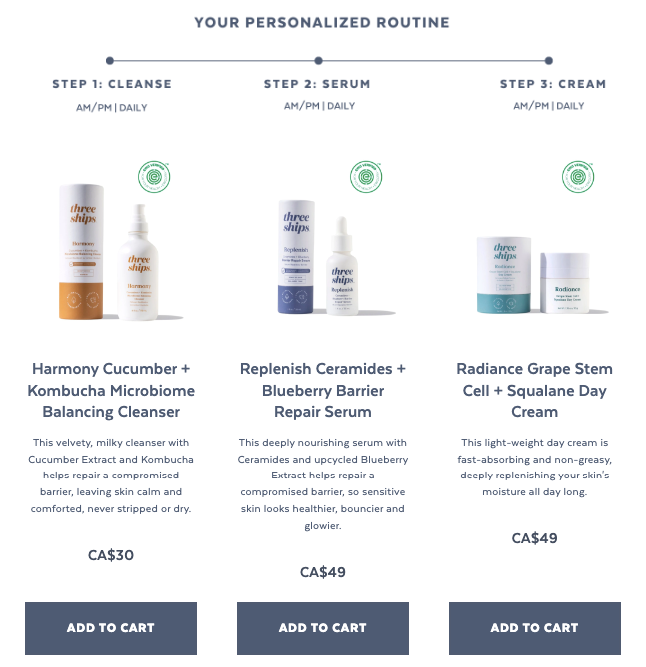 Sure, this email features a bunch of products, which ordinarily wouldn’t be super engaging. But because they’re positioned as part of a personalized skincare regimen, it feels like you’re receiving something valuable, not just another hard sell.
Sure, this email features a bunch of products, which ordinarily wouldn’t be super engaging. But because they’re positioned as part of a personalized skincare regimen, it feels like you’re receiving something valuable, not just another hard sell.
It’s almost like you’re a Hollywood star being given a routine that’s perfectly tailored to your needs ahead of your next leading role.
Or at least that’s how I like to imagine it.
Whether or not you agree, it’s impossible to deny that customers love this kind of bespoke messaging. Indeed, almost three-fifths of consumers say they’re more likely to become repeat buyers after a personalized shopping experience with a retailer.
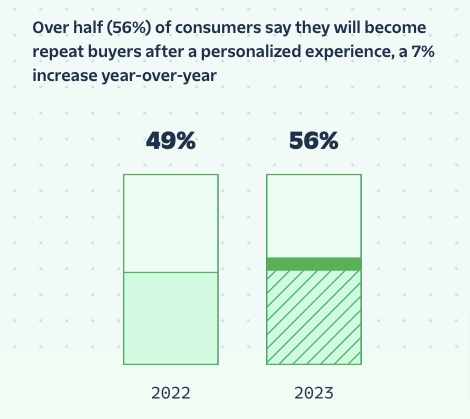
3. Run an Onsite Campaign Promoting Relevant Products
Sure, email marketing is great.
But you also need to reach casual shoppers beyond the inbox.
That means hitting them with targeted popups, sidebars, and slide-ins displaying relevant product recommendations, based on the results of your onsite quiz.
Again, Three Ships gets it right here:
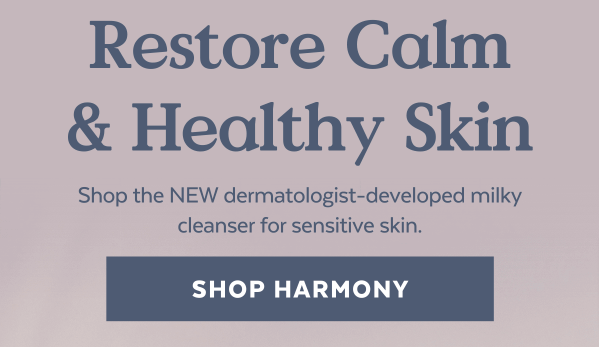 And have you noticed that, up to this stage, we haven’t even hinted at offering the customer a discount?
And have you noticed that, up to this stage, we haven’t even hinted at offering the customer a discount?
There’s a clear lesson here: if you take the time to truly understand casual shoppers, you stand a far better chance of driving that all-important second purchase.
4. Share a Discount Code
If, after all those targeted product recommendations, you still haven’t closed the deal, it’s time to step things up by offering a discount code.
But not just any old discount; give your casual shopper the chance to save money on the types of products they highlighted during your onsite quiz.
Again, Three Ships nailed it:
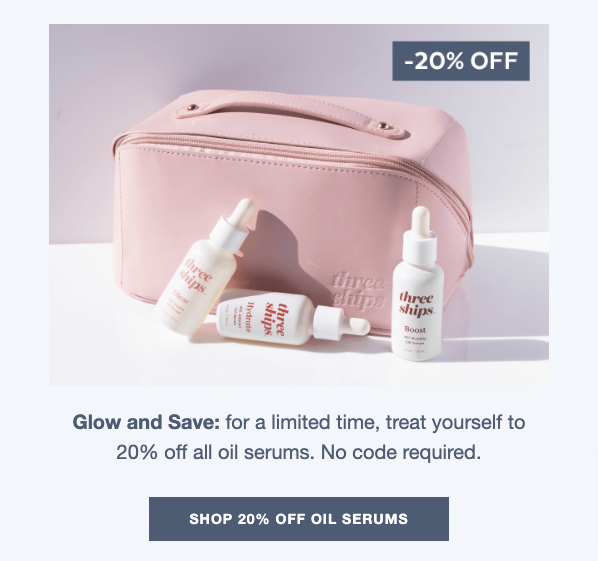 We told them we <3 oil serums, so hey presto, they conjured up a 20 percent discount on that specific product category. When marketing is this personalized, it really doesn’t feel like selling at all.
We told them we <3 oil serums, so hey presto, they conjured up a 20 percent discount on that specific product category. When marketing is this personalized, it really doesn’t feel like selling at all.
Strategy #2: Build Out Your Content Calendar
Not all strategies involve workflows.
While those complex, multi-stage strategies often get all the glory, you can enjoy just as much success with a single email or popup—provided you get the messaging right.
This approach is all about thinking beyond the “classic” marketing emails you already send and building a content calendar designed to attract, convert, and delight casual shoppers.
Of course, the perfect approach will vary from one brand to the next, but it should combine some or all of these elements:
| Onsite | ||
| Attract | Engagement emails: drive people to your site by promoting a quiz, blog post, recipe, etc Referral emails: promote your social channels and referral program |
Promote guides Share product information Run a quiz Offer downloadable content |
| Convert | Sales emails: tell casual shoppers your new sale has begun Seasonal emails: tailored to events like Valentine’s Day, Mother’s Day, Black Friday, etc. Promotional emails: highlight a specific product or category |
Promote your sale Run embedded “shop the look”-style promotions Promote specific products or categories |
| Delight | Curation emails: share popular content Brand-building emails: share your values, brand story, and behind-the-scenes content |
Highlight your value proposition Promote customer service Run exit-intent surveys |
In general, aim to send X attract, X convert, and X delight emails per month to give your messaging the best chance of hitting home with casual shoppers.
Strategy #3: Nail Your Post-First-Purchase Campaigns
What’s the best chance to sell to casual shoppers? Right after they’ve placed their first order.
At that point, they’re already in the buying mood, and your brand feels shiny, new, and exciting. Don’t give those heart eyes a chance to fade—strike while the iron’s hot with this killer post-first-purchase strategy:
1. Send Post-First-Purchase Emails
To be clear, when we say “post-first-purchase emails”, we’re not talking about transactional emails like order confirmations and shipping updates.
Those are a minimum expectation. On top of that, you also need a dedicated post-first-purchase workflow incorporating four essential elements:
- Thank you message
- Review request
- Product information
- Upsell/cross-sell offer
Let’s see those steps in action courtesy of flower and plant delivery company Bloom & Wild.
Following your first purchase, they share a heartfelt thank you message that also asks if you’d be kind enough to review your order:
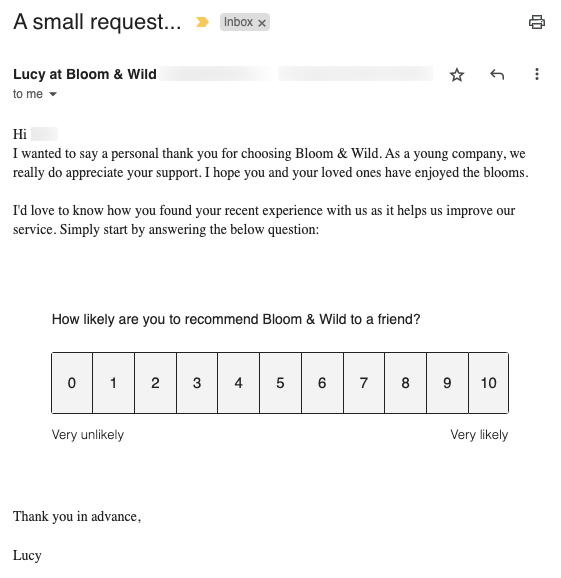 Just like that, they’ve ticked off the first two elements of a perfect post-first-purchase workflow.
Just like that, they’ve ticked off the first two elements of a perfect post-first-purchase workflow.
Once the delivery has been made, they follow up with a brief explanation of how to look after your flowers, plus a link to an in-depth plant care guide on their website:
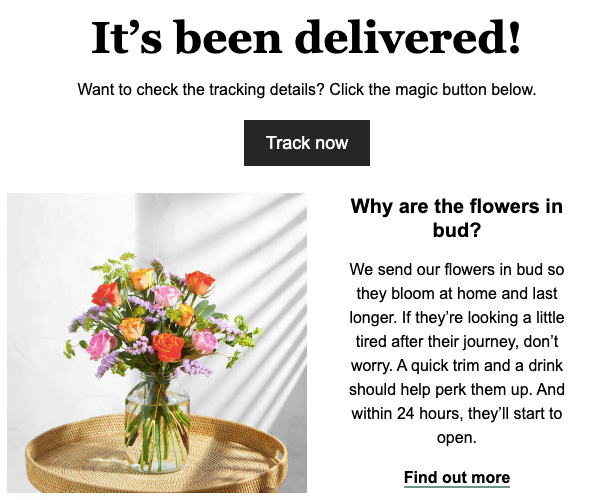 Having received your beautiful floral arrangement, you might be thinking about sharing the love with your nearest and dearest.
Having received your beautiful floral arrangement, you might be thinking about sharing the love with your nearest and dearest.
To that end, the final step in Bloom & Wild’s post-first-purchase sequence includes a discount code encouraging you to splurge on gifts:
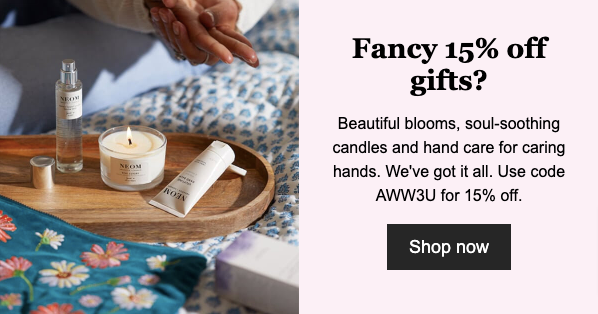 From start to finish, this feels less like a sales sequence, and more like a brand genuinely wanting customers to get the most from their purchases.
From start to finish, this feels less like a sales sequence, and more like a brand genuinely wanting customers to get the most from their purchases.
That’s how you turn casual shoppers into repeat buyers.
2. Add a Discount Code To Your Receipt Page
A week might be a long time in politics, but it’s an eternity in the fast-paced world of ecommerce.
Once a customer leaves your site after making their first purchase, there’s a good chance they won’t think about you again until their order arrives. They might never come back.
So get them thinking about their next purchase by including a discount code on your receipt page, just like Bloom & Wild does:
![]() Pro tip: For a more seamless customer experience, share the same discount code in your post-first-purchase email workflow.
Pro tip: For a more seamless customer experience, share the same discount code in your post-first-purchase email workflow.
Strategy #4: Say “Goodbye”
Like it or not, some customers are destined to buy once and never again.
Maybe they didn’t like your product. Maybe your brand just didn’t resonate with them. Or maybe they had a very specific itch—and now you’ve helped them scratch it, they’ve moved on.
Either way, they’ve gone, and it looks like they’re not coming back.
Keeping these checked-out customers subscribed to your email list isn’t doing anyone any good, so it’s time to make one last Hail Mary attempt to re-engage them.
And if that doesn’t work, bid them adieu.
1. Build a Sunset Workflow
A sunset workflow is about starting the painful process of breaking up with a casual shopper, while extending an olive branch that might—maybe, hopefully—coax them back to your store. It comes in two parts:
- An “Is this really it?” email
- The emotional final goodbye
Again, let’s see how this looks IRL, this time courtesy of the good folks at Black Travel Box.
For the first step in their workflow, they’re totally upfront, pointing out that the customer hasn’t been engaging with their emails and asking “what gives?”.
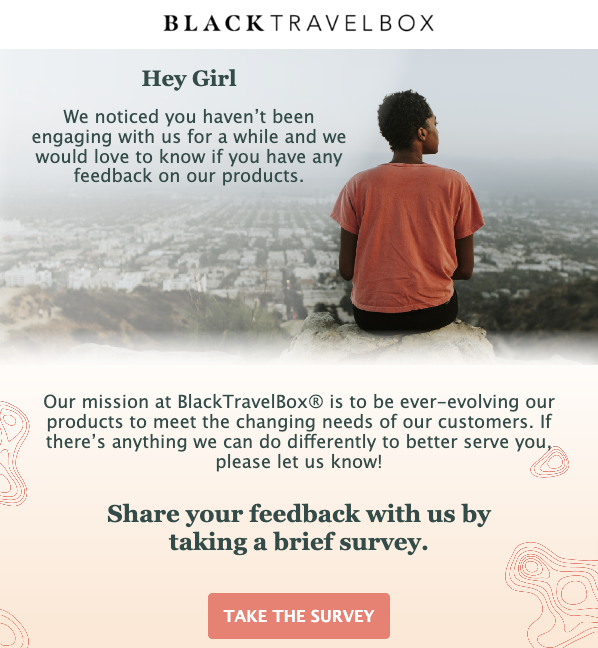 As you’ll have realized, their use of a feedback survey neatly links this workflow to our first strategy about getting to know your casual shoppers. If they respond, problem solved: you can loop them into a whole other workflow and start sharing personalized product recommendations.
As you’ll have realized, their use of a feedback survey neatly links this workflow to our first strategy about getting to know your casual shoppers. If they respond, problem solved: you can loop them into a whole other workflow and start sharing personalized product recommendations.
But if the recipient doesn’t engage, Black Travel Box follows up with this goodbye email:
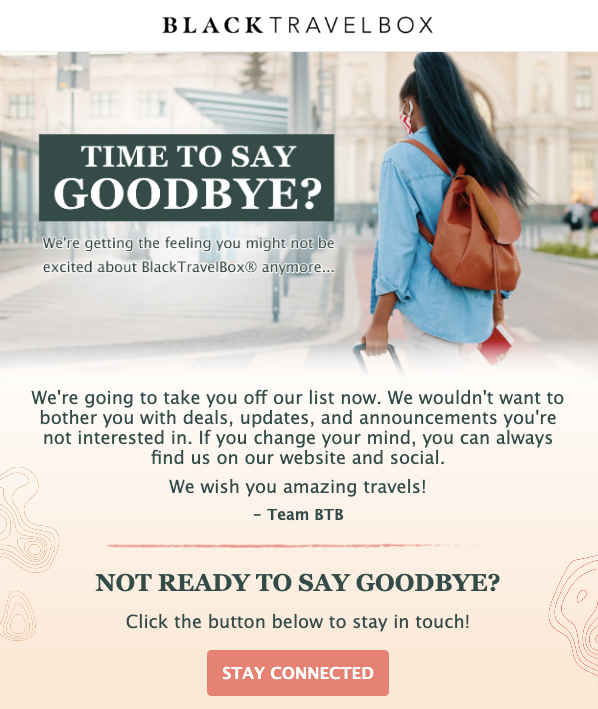 For my money, they strike exactly the right tone here.
For my money, they strike exactly the right tone here.
Rather than trying to make casual shoppers feel bad for not reading their emails, they strive to part on good terms—while offering the customer one final chance to stay subscribed.
If only every breakup was this amicable!
2. Unsubscribe & Deactivate Lapsed Accounts
When a customer completes your sunset workflow without engaging in any way, shape, or form, there’s only one thing for it: remove them from your marketing list and deactivate their account.
Don’t feel too bad.
Sure, it’s a shame they never became a repeat customer. But on the flip side, they were spoiling your engagement metrics by never opening your emails. And if you end up with a bunch of lapsed customers on your email list, you might even run into deliverability problems.
Honestly, you’re better off without them.
Create Customer-First Strategies With Drip
By this point, it’s probably clear that you can only implement these customer-first casual shopper strategies with a little help from your marketing automation platform.
Specifically, you need a platform capable of identifying and segmenting casuals, then targeting them with beautiful, on-brand emails and onsite campaigns.
In short, you need a tool like Drip.
Test-drive our proven ecommerce workflows by signing up for your free 14-day trial today!
